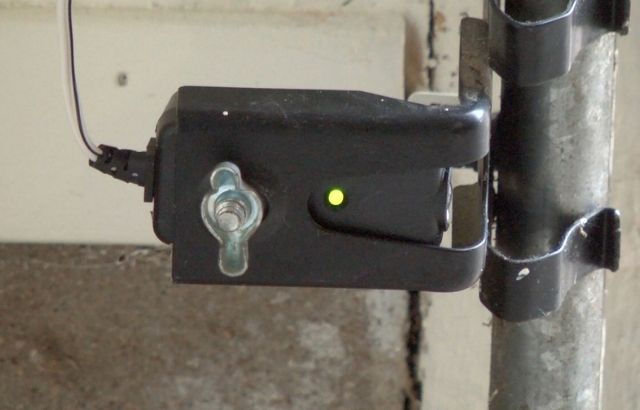A Lazy Susan is a rotating closet addition for a corner cabinet in a kitchen. Likely, many people do not know how to adjust this properly, so today, we bring you how to adjust a Lazy Susan cabinet pole.
A Lazy Susan consists of two or three circular shelves around a central axis. If this axis is not aligned correctly, it can prevent doors from closing or shelves from rotating smoothly.
The rotating shelves of a Lazy Susan work well in this type of cabinet because the cabinet pole can be quite large with a small door opening. This makes it difficult to access the recesses.
You can adjust a Lazy Susan cabinet shaft in a few minutes with a few hand tools.
How to Adjust a Lazy Susan Cabinet Pole: Tools Needed
- Eraser
- Flashlight
- Pencil
- Phillips screwdriver
- Standard screwdriver
- Wrench or ratchet set
Learn More: How To Remove Hair DYE From Wood Cabinets
How to Adjust a Lazy Susan Cabinet Pole: Steps
Step 1: Correcting a bad rotation
- The most important thing is to identify where the rotation problems are occurring.
- If your Lazy Susan is stiff, it isn’t easy to rotate. This problem is caused by the center pole or the position of your bottom shelf.
- To do this, rotate the Susan slightly and observe where it locks.
- If the shaft starts to bind, it will prevent free rotation. In this case, the shelf must be loosened.
- If the circular shelves slide down the center shaft, the bottom shelf may start to drag, making it difficult to rotate.
- In this case, you must adapt the height of this shelf to solve the problem.
- Locate the locking screw so that the center shaft can be adjusted.
- Look closely at the top of the center shaft.
- You should find a large bolt that locks the outer shaft to a metal sleeve placed inside the post.
- This is the shaft locking bolt.
- This bolt holds the center shaft in place and retains the position of the post.
- Sometimes, excess pressure on this bolt can cause the shaft to bind.
- On some models, the locking bolt may be located on the bottom of the Susan.
- However, in most cases, it is located near the top.
- In some cases, this can be solved by adjusting lazy Susan cabinet door hinges.
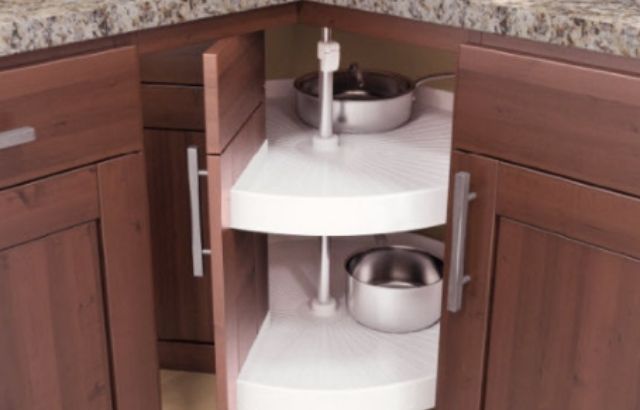
Loosen the bolt.
- If you have things inside your Lazy Susan, take them out, so you have more room to work.
- We recommend using a wrench or ratchet. Loosen the bolt by turning the bolt counterclockwise one-quarter full turn.
- At first, the bolt will need force to loosen.
- Only loosen the screw enough to be able to manipulate the central shaft.
- Generally, it is best to loosen the bolt a little at a time. This will prevent excessive loosening, which could cause the Susan alignment to come out.
Move the adjusting rod.
- Now that the bolt is loose, you can adjust the center shaft.
- Slide the metal adjustment sleeve that the bolt was held in place no more than 1 inch (2.6 cm) to provide better clearance between the center shaft and the top of the cabinets.
- Work slowly as you tighten the center shaft. Over-tightening can cause the Lazy Susan to be damaged.
- Tighten the bolt to finish tightening the center shaft.
- Use your wrench or ratchet to carefully re-tighten the locking bolt back into place.
- Do not overtighten the bolt. It should be looser than initially but still tight enough to hold the adjusting rod in place.
- Locate the locking screws for shelf posture adjustment.
- Almost all Lazy Susan’s should have two or more locking screws located in the center of each shelf.
- The screws hold the shelves on the central axis.
- When the front decorative panel joins all the shelves, the entire shelf mechanism will have to be adapted.
- In such a case, the screws are not located at the height of the shelves.
- If the shelves are to be adjusted separately, you will only need to work with the bottom bracket.
- Place the locking screws on the bottom shelf only.
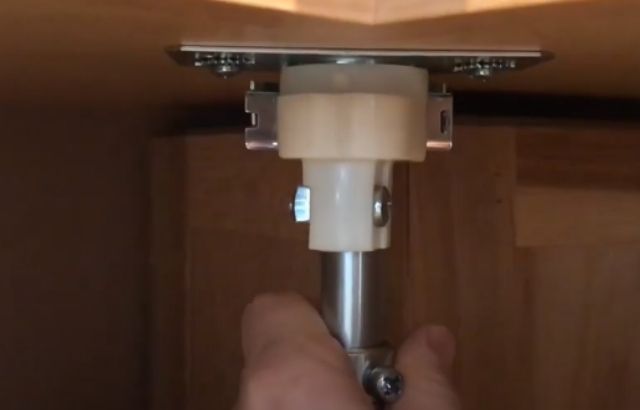
Loosen the screws
- Loosen the locking screws with a Phillips screwdriver or similar tool.
- Hold the screwdriver so that its head meets the fastener directly.
- Apply firm downward pressure on the screw while turning it counterclockwise to avoid stripping the hardware.
- The screws can be left in their holes once they have been disengaged from the center shaft.
- However, you may wish to place the screws loosely to one side to avoid losing them.
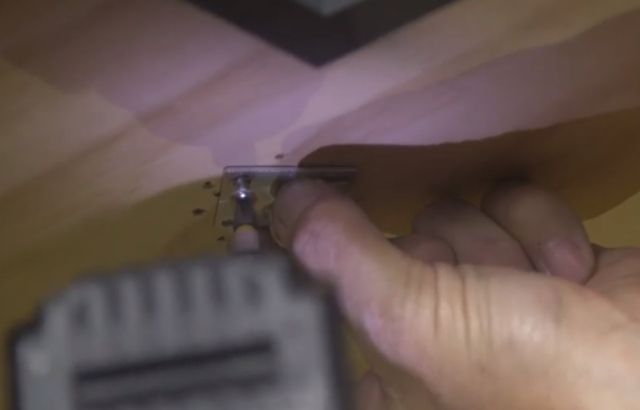
Lift the shelves to finish adjusting the shelf position
- Carefully lift the bottom shelf or the entire shelf system until there is approximately one-half inch (1.26 cm) of space between the bottom bracket and the cabinet’s bottom.
- The shelves may resist this readjustment and begin to lock on the central axis.
- Maneuver the shelves until they are level and at the proper height.
- In any case, the central shaft must not be lubricated.
- Doing so may prevent the screws from holding in position.
Tightening the screws
- Hold the shelf in place with one hand and use your free hand to tighten the locking screws in place with a screwdriver.
- Be careful not to let the shelf slip when replacing the fasteners, as this could cause it to become uneven or jam.
- Tighten the screws as much as necessary without removing any hardware. The shelves must be fixed and secure to avoid this type of misalignment.
Step 2: Correcting insufficient top, bottom, and side clearance
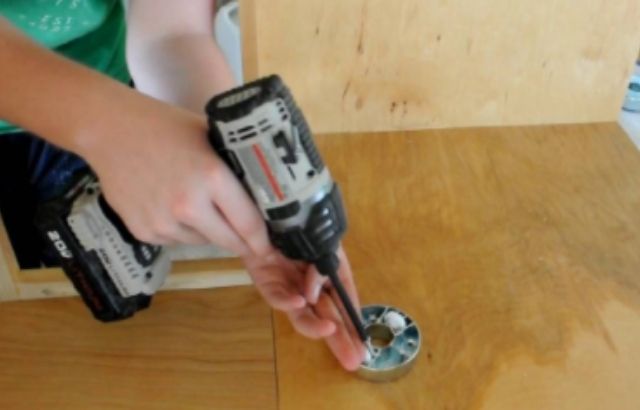
Remove the retaining clip to improve top and bottom clearance 2
- Locate the plastic retaining clip on the bottom of the center shaft. Grasp the clip firmly between your fingers, open it and remove it.
- Below the clip should be a cut-out portion of the shaft with a thumbscrew adjusting wheel.
- The cabinet should be empty when making this adjustment.
- Do not attempt to finish the process when the shelves are full, especially if they are complete.
- You can observe if the lazy Susan stopper is positioned correctly.
Turn the adjustment wheel.
- Use your fingers to turn the collar screw adjustment wheel on the cut-out part of the center shaft.
- Turn the wheel clockwise to raise the doors and counterclockwise to lower the gates.
- Typically, it is expected that for each full turn of the screw. Your height will adjust approximately 1/32 in. (0.8 mm).
- It may be advisable to press lightly on the bottom of the bottom shelf to assist with the adjustment if you try to raise the door.
Replace the retaining clip to complete the top and bottom adjustment
You should check the style of the pole. After adjusting the gate to the proper height, return the retaining clip to its original position on the bottom of the rod. The hook should snap firmly back into place.
It may be a good idea to tighten all set screws connected to the centre shaft, shelves, and gate after adjusting the height.
Doing this may prevent the door from becoming misaligned again.
- Profile the lower and upper corners when there is insufficient lateral space.
- With an erasable pencil, lightly outline the current position of the top and bottom brackets.
- If the cabinet’s lighting is too poor to easily make these marks, use a flashlight or electric flashlight.
- In this way, you will have a reference point to make the necessary adjustments. The pencil marks can be erased once you complete the process.
Realign the pivot post from the top
- Use a screwdriver to remove the adjusting screws. And loosen the star washers that hold the pivot bracket in place on each side of the pivot pole.
- Adjust the pivot cover and pivot post so that both are aligned and centered.
- When the star washers are in place, back up one step and observe your Lazy Susan.
- If the lateral clearance is still uneven, remove the washers and refit the pivot.
Re-tighten the pivot housing
Once you tighten the star washers, you are ready to return the set screws to their original position.
When the screws are in place, recheck the Lazy Susan’s side clearance to ensure that it has not been altered when the hardware is reattached.
This adjustment may solve your side clearance problem. If the bottom half of your Susan appears to be misaligned, you will need to adjust the pivoting base together with the top part. You will need to check the vertical pole.
Realign the pivot base when necessary
- Open the door wide enough to observe the bottom bracket on each side of the Susan.
- Loosen this bracket by removing the set screw and star washer with a screwdriver. You can now realign the base of the metal arm so that it is centered.
- All of this will need to be repeated on the opposite side of the Lazy Susan, where you will find an identical bracket cam base.
- Work on the brackets one at a time. After you have disassembled, realigned and re-clamped the first bracket, move on to the next one.
- When properly centered, the pivot cam bases on both sides should be aligned concerning the center post.
Re-tighten the bracket
- Be careful when re-buckling; if you push the pivot cam, it may become misaligned.
- Replace the star washers and replace the set screws for the bracket.
- When fastened, similarly adjust the base of the lower bracket cam on the opposite side.
- Please verify that the position was not altered while returning these parts to their original works by stepping back and assessing the side clearance’s evenness.
- You should always set the pole over time. Patience is key. At this point, it is ideal for checking the pole diameter.
- Check the door to complete the lateral clearance adjustment.
- Sometimes these alignments (especially those made on pivots) may require several attempts before they are fixed.
- Recheck the door alignment after completing the top and bottom adjustments, especially.
- If the side clearance is still uneven, you will need to readjust the upper pole or lower pivot cams.
- One last fact to consider is that whether your lazy Susan is attached to the cabinet door.
How to Adjust a Lazy Susan Cabinet Pole: FAQ
How to adjust the door of a corner cabinet?
If tightening the mounting screws did not solve the problem and the door is still too high or too lowered, look for the screw that adjusts the door up and down.
If you can’t find a separate screw for this, loosen the two adjusting screws on the two hinges, adjust the cabinet door to the desired size, and re-tighten the screws.
How do you get a lazy Susan unstuck?
To fix loose screws in the Lazy Susan, use a screwdriver to drive the screws into place. If one of the plates has loosened or is torn, you will need to replace the plate with a new one.
Therefore, you must remove the screws holding the plate in place and then remove the container.
How do you remove a Lazy Susan from a corner cabinet?
Remove all items from the Lazy Susan shelves and set them aside.
Make use of a screwdriver if you want to remove the screws that secure the bracket on the top of the old Lazy Susan in place.
Carefully pull off the top of the former Lazy Susan assembly toward you and remove the entire cabinet assembly.
Last Words
It may seem like a simple task. It is, however, a long job, and you must have the right tools. This work is left to the experts; otherwise, you can follow our steps. A great idea that can help you is to remove a lazy susan from a corner cabinet.
Placing it somewhere else can be ideal. Many times it is good to check the kitchen base cabinet. This way, you can correct the pole in position. Hope you learn how to adjust a Lazy Susan cabinet pole.


